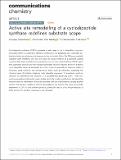Files in this item
Active site remodelling of a cyclodipeptide synthase redefines substrate scope
Item metadata
| dc.contributor.author | Sutherland, Emmajay | |
| dc.contributor.author | Harding, Christopher John | |
| dc.contributor.author | Melo Czekster, Clarissa | |
| dc.date.accessioned | 2022-08-26T16:30:11Z | |
| dc.date.available | 2022-08-26T16:30:11Z | |
| dc.date.issued | 2022-08-25 | |
| dc.identifier | 280978191 | |
| dc.identifier | ad377a64-b034-4182-aae2-ad7a2f5f111a | |
| dc.identifier | 000844786200001 | |
| dc.identifier | 85137118604 | |
| dc.identifier | 36518199 | |
| dc.identifier.citation | Sutherland , E , Harding , C J & Melo Czekster , C 2022 , ' Active site remodelling of a cyclodipeptide synthase redefines substrate scope ' , Communications Chemistry , vol. 5 , no. 1 , 101 . https://doi.org/10.1038/s42004-022-00715-2 | en |
| dc.identifier.issn | 2399-3669 | |
| dc.identifier.other | ORCID: /0000-0002-7163-4057/work/117996709 | |
| dc.identifier.other | PubMedCentral: PMC7613923 | |
| dc.identifier.uri | https://hdl.handle.net/10023/25899 | |
| dc.description | Funding: CJH and CMC are funded by the Wellcome Trust (210486/Z/18/Z) and ES is funded by the Cunningham Trust (PhD-CT-18-41). | en |
| dc.description.abstract | Cyclodipeptide synthases (CDPSs) generate a wide range of cyclic dipeptides using aminoacylated tRNAs as substrates. Histidine-containing cyclic dipeptides have important biological activities as anticancer and neuroprotective molecules. Out of the 120 experimentally validated CDPS members, only two are known to accept histidine as a substrate yielding cyclo(His-Phe) and cyclo(His-Pro) as products. It is not fully understood how CDPSs select their substrates, and we must rely on bioprospecting to find new enzymes and novel bioactive cyclic dipeptides. Here, we developed an in vitro system to generate an extensive library of molecules using canonical and non-canonical amino acids as substrates, expanding the chemical space of histidine-containing cyclic dipeptide analogues. To investigate substrate selection we determined the structure of a cyclo(His-Pro)-producing CDPS. Three consecutive generations harbouring single, double and triple residue substitutions elucidated the histidine selection mechanism. Moreover, substrate selection was redefined, yielding enzyme variants that became capable of utilising phenylalanine and leucine. Our work successfully engineered a CDPS to yield different products, paving the way to direct the promiscuity of these enzymes to produce molecules of our choosing. | |
| dc.format.extent | 10 | |
| dc.format.extent | 2735698 | |
| dc.language.iso | eng | |
| dc.relation.ispartof | Communications Chemistry | en |
| dc.subject | Aminoacyl-Transfer-RNA | en |
| dc.subject | Structural basis | en |
| dc.subject | 2,5-Diketopiperazines | en |
| dc.subject | Cyclo(his-pro) | en |
| dc.subject | Reveals | en |
| dc.subject | Enzymes | en |
| dc.subject | Family | en |
| dc.subject | QD Chemistry | en |
| dc.subject | QH301 Biology | en |
| dc.subject | DAS | en |
| dc.subject | MCC | en |
| dc.subject.lcc | QD | en |
| dc.subject.lcc | QH301 | en |
| dc.title | Active site remodelling of a cyclodipeptide synthase redefines substrate scope | en |
| dc.type | Journal article | en |
| dc.contributor.sponsor | Cunningham Trust | en |
| dc.contributor.institution | University of St Andrews. School of Biology | en |
| dc.contributor.institution | University of St Andrews. Biomedical Sciences Research Complex | en |
| dc.identifier.doi | https://doi.org/10.1038/s42004-022-00715-2 | |
| dc.description.status | Peer reviewed | en |
| dc.identifier.grantnumber | en |
This item appears in the following Collection(s)
Items in the St Andrews Research Repository are protected by copyright, with all rights reserved, unless otherwise indicated.

